
Preparedness for Effective Implementation of FRA 2006: Accountable Governance System to Ensure Biodiversity Conservation and Sustainable Use for Livelihood and Food Security of Tribal and Other Traditional Forest-Dwelling Community
⦁ Introduction: The Background
Tribal and other forest-dwelling communities have intimate symbiotic relationships,and the life cycle of the tribal Community is organically connected with the forest ecosystem.
The tribal communities whose survival and livelihood are traditionally linked with the forest mosaic landscape are facing the challenge of maintaining their livelihood security due to the degradation of the forest and other natural resource base of the tribal habitats. The problem is further aggravated with the changing climate. Such degradation of the natural resource base is also causing erosion of the rich traditional knowledge and practices of the tribal communities related to management of the natural ecosystems, loss of genetic diversity, degradation of natural resource endowments such as soil, water, forest, and biodiversity, and wearing down of the traditional social institutions and social processes of the tribal Community for conservation of the natural ecosystems.

It has been realized that sustainable and holistic tribal development cannot be achieved by adopting any sectoral or piecemeal approaches of land management by Gram Sabha, ignoring the support of the government functionaries, forest department in particular. It requires an approach of Integrated Landscape Management for the agro forest mosaic landscape of the tribal habitat to understand the interlinkages of different components of the ecosystems and develop strategic actions to strengthen their interlinkages. The tribals generally are either smallholder farmers or landless and have feeble voice at the Gram Sabha where power lobby of vested interest are the decision makers. To ensure the livelihood security of the tribal smallholder farmers, their natural forest resource endowments have to be improved, and their livelihood opportunities need to be diversified. Such diversification provides the safety net to reduce risk from failure of any one of the activities due to various reasons including the erratic climatic conditions, provides opportunities for increasing the work participation rate of both men and women, and creates scope for family farming.
1.1 Background of the Felt-need of the Forest Rights Act
Following the National Forest Policy of 1952 and Forest Conservation Act of 1980, which focused on protecting the forest and under the central Government’s control, India has almost centralized control of state forests. The country has several initiatives for collaborative forest management system in Joint Forest Management (JFM) in nearly all the states. There has been some success of the JFM. that attracted many externally funded projects implemented to facilitate JFM where Community have different degrees of roles in forest conservation since 1990-91. But there has not been equitable benefits to the tribal Community, particularly the small groups of PVTGs (Particularly Vulnerable Tribal Group) and displacement of forest dwellers have caused concern due to eviction from their traditional homesteads by the Government seeking to consolidate the enclosure process under the Wild Life Protection Act of 1972. Some united social movements working with forest users across the country have compelled the Government to review the situation, take action, and have the Scheduled Tribes and Other Traditional Forest Dwellers Act (or Forest Rights Act – FRA). However, the Act was passed in December 2006 but came into force on January 1, 2008, with appropriate rules. The FRA provides for restitution of traditional forest rights to forest dwellers across India, including individual rights to cultivated land in forested landscapes and collective rights to control, manage and use forests and its resources as common property. Even after approval of Forest Right Acts, it has been facing several hurdles in successful implementation. Successful implementation of the FRA requires preparedness at Gram Sabha and coordination between several departments-the tribal, forest, revenue and local self-government that are unable to work in concert. Sustainable and holistic tribal development can be achieved by strengthening the grass root institutions and adopting technology and scientific knowledge required for forest ecosystem management at the landscape level, beyond the scattered individual villages.

Part I
2.0 Advent of the Forest Act 2006
FRA 2006, as a historical move for judicious rights with built-in responsibilities, opens a plethora of opportunities and challenges for both Government functionaries and the Community at the local Gram Sabha level. It enables the Gram Sabha for creating space for the Community to practice their traditional knowledge and customary systems adopted for conservation of their community resources, including the community forest resources in a democratic manner.
The Act 2006 is a well-spelt Act where both “means and ends” are distinctly articulated in terms of rights (as in Section 3(i) and responsibilities (as in Section 5) of forest-dwelling Scheduled Tribes and Other Traditional Forest Dwellers as an authority. As per Section-2 (a) of the FRA, the “community forest resources” (CFR.) means customary common forest land within the traditional or customary boundaries of the village or seasonal use of landscape (in the case of pastoral communities) including reserved forests, protected forests, and protected areas such as Sanctuaries and National Parks to which the Community had traditional access.
Gram Sabha shall be the authority to initiate the process.A forest right committee will be formed at the Gram Sabha to create awareness among the Community and invite applications, as the Act’s terms.
2.1 Gram Sabha– Its’ Infrastructure and Expertise
The Gram Sabha, being the democratic institution, often with PVTGs as a minority, at the grass-root, are supposed to pass a resolution after verification and forward the application of deserving candidates to the Subdivision Level Committee with a map for determining the nature and extent of individual or community forest rights or both rights. One has to appreciate the limited infrastructure, expertise and dominance of power lobby to influence any decision at the Gram Sabha level. It takes a longer time at the Gram Sabha and Subdivision, District levels and finally at the State Level to granting the rights. There is no ambiguity about the process of approval, as mentioned in FRA Section (5). “The State Government shall constitute a District Level Committee to consider and finally approve the record of forest rights prepared by the Subdivisional Level Committee.” Following Section (6) “The District Level Committee’s decision on the record of forest rights shall be final and binding.”
There will be three departments, (i)Revenue,(ii) Forest, and (iii)Tribal Affairs of the State Government as members of Sub-Divisional-Level Committee, District-Level Committee, and the State-Level Monitoring Committee to approve the application. The Panchayat functionaries and of Tribal Community will be an ideal group for oversight and monitoring. But many of the applications are rejected on the whimsical ground. Moreover, the applicants are not informed officially to resubmit the required documents or evidence, mentioned in the FRA
2.2 The Scheduled Tribes and Other Traditional Forest Dwellers (Recognition of Forest Rights) Rules, 2008, as amended by the Ministry of Tribal Affairs in 2012, under Rule 4 i1) (e), provide that Gram Sabha shall constitute “Committees for the protection wildlife, forest and biodiversity from amongst its members, to carry out the provisions of section 5 of the Act.” It is tough tofind someone among all the Gram Sabha to understand the nature of interdependence of biodiversity, the role of pollinators, endangered species as per IUCN Red data book, andlevel of carbon sequestration at the forests. Gram Sabha needs strengthening its institution with appropriate technology, experts, maybe a local forester to begin with, before it takes charge of managing the considerable forest landscape, spread over several Gram Sabha boundaries. It has to organize the management system before it is too late to face irreversible ecological sustainability.
The procedure seems a simple process, but it is taking more time thanit should take.
2.3 Situation Analysis of the Existing System and Expected Roles of Different Actors
The Gram Sabha has many other responsibilities to work for and is neither prepared nor competent to inspect the forest resource and monitor the ecological process. There has to be preparedness at social, political, technical, and legal at different levels. The Tribal and other communities have their social system, structure, and institutions for traditional forest management cultural practices. It takes time to change the social system, institutions, and cultural traditions of the people. One has to plan for a systematic approach for socio-ecological change compatible with the requirement of rights as mentioned in FRASection 3 (i) and duties of right holders as discussed in Section (5) particularly for wildlife and biodiversity conservation. The FRA demands the right holders to ensure that adjoining catchments area, water source,and other ecologically sensitive areas are adequately protected. Such a catchment area will not necessarily be confined to a single CRF and will be spread over Gram Sabha cluster. This has been causing a conflict of interest among the Gram Sabha. Here, one needs an expert to assess the causal factor for damage due to overharvesting by the members of one CFR and hurting the other CFR.

Participatory planning exercise at Ghoghra Village involving local panchayat
2.3 Plurality of Tribal Culture, Multiplicity of Acts, and Statutory Committees
The Tribal society is not homogeneous. Different types of Particularly Vulnerable Tribal Groups (PVTG)s have different cultural traditions for their subsistence. The cultural practices will not change immediately after the introduction of the FRA 2006. One has to consider the other existing form of community organization or groups formed to meet the requirements of different Acts/policies/programs such asthe Biological Diversity Act 2002, C.A.M.P.A. Act 2016– Rule 2018, Wetland Policy, Wildlife Protection Act 1972, Indian Forest Act 1927, Forest Conservation Act 1980, Environment Protection Act 1985, Joint Forest Management. Joint Forest Management Committees, Biodiversity Management Committees, and many other community groups of the S.T. and Other Tribal Forest Dwellers (OTFD). Such committees have already been formed with the actual state’s agenda for the forest and biodiversity conservation.Government of India has signed several international treaties. Some of them are United Nations Framework Convention on Climate Change,Convention of Biological Diversity, U.N. Convention to Combat Desertification, Wildlife Conservation, Ramsar Convention, Convention on Sustainable Development. It requires a comprehensive and uniform approach to address the issues that single Gram Sabha may not take uplocally. Hence, it requires comprehensive monitoring by the experts at Sub Division Level, District Level, and at the National level where the country is answerable at the international level.
2.4 Several Other Factors as Bottleneck
Thus, while there have been simple procedures, the Act’s successful implementation has been taking longer and attracts debate at different levels. FRAwas enacted in 2006 by the Indian Parliament with the Rules for its performance having comeinto force in 2008. However,after more than a decade of its implementation, the result is far from what is desired. Number of studies have highlighted issues that have created impediments for effective implementation of the Act such as “local political climate and interests” (Lee and Wolf 2018), vested political interests at specific geographical locations (Sen and Pattanaik 2019), complex process that requires coordination and participation of different stakeholders (Khosla and Bhattacharya 2018; Lee and Wolf 2018), lack of coordination between the tribal, revenue, and forest department, and existence of multiple laws that are in conflict to operationalize FRA on the ground (Oxfam), diluting the Gram Sabha/local government’s decision-making power and vesting it with the government machinery by the Rules (Bhullar 2008), non-availability of the land records (Bose 2010), challenges of understanding the law to facilitate the application procedures for claim determination (Lee and Wolf 2018), lack of awareness among the tribal population about the rights bestowed upon them by the Act (Khosla and Bhattacharya 2018), lack of awareness programs and suitable trainings especially for the PVTGs to change their cultural habits (Wilson and Rajesh 2018).
2.5 Issuesof Awareness, Capability and Governance System
The authors’ views about the need for an accountable governance system, as required for implementing the FRA Act, arenarrated in the following section. Accountable governance ensures that government officials or the Gram Sabha’s actions and decisions are subject to inspection or oversight to ensure that Governance System meets their responsibility as stated in Section 5 of the Act. It has to be implemented in such a way that the needs of the Community as their rights stated in the Act are met. The notion of accountability is often vague because the function of the governance system members in the Governance System isnot articulate with measurable indicators of each actor’s performance in the hierarchy.
Therefore, the concept of accountability involves two distinct stages:
(i) Answerability of the governance system – to provide information about their program decisions and actions. There has to be an effective strategy for I.E.C.
It is the District-Level and Subdivision-Level functionaries’ responsibility for disseminating information and generating awareness of the FRA so that people come forward to file claims for user rights to forest resources. “There was no systematic effort to disseminate information about the Act and its provisions to F.R.C. members or the Gram Sabha. The first meeting of the Gram Sabha was the only platform for people to know about the Act. Officials of the revenue and forest departments were instructed to organize the process, which they did in a campaign mode over a period of 5-7 days across the state. Most of the meetings lasted one to three hours during which the presiding officer explained the basic provisions of the Act. The F.G.D.s revealed low levels of awareness about the provisions of the Act. In some districts like Mandla in Madhya Pradesh, claims for user rights were entertained only in forest villages. There was no clarity on whether claims could be filed for forest resources in revenue land.”– UNDP
(ii) Preparedness for implementation by accountable governance system –
The governance system has to build competency and strategic plan for implementing the program and sanction the offending party or remedy the contravening behavior. The authors suggest developingparticipatory and scientific criteria and indicators to assess performance on the outcome as expected implementation to protect the wildlife, forest, and biodiversity. As per the Act there has to be the improvement of the adjacent catchment area, water, protection against the mark of any destructive practices affecting the cultural and natural heritage as mentioned in Section 5 of the Act.
Keeping in mind the above challenges the following sections intend to analyze the Government departments and Community’s contextual preparedness, Gram Sabha in particular for effective implementation of FRA 2006.
3.1 Preparedness for Cultural Transformation and Bureaucratic Reorganization
Since the indigenous Community, tribal, and other forest dwellers have symbiotic relationships with the forests and coexist, the sustainability of the forests will depend upon the sustainability of the development of the tribes. Indigenous peoples with a historical continuity of resource-use practices often possess a broad knowledge base of complex ecological systems’ behaviour in their own localities. This knowledge has accumulated through a long series of observations transmitted from generation to generation (Gadgil M et al 1993). The tribals coevolve with natural forests with their rich knowledge and cultural practices. The tribals or any other community will have their own social system with the institution and cultural practices as guiding norms to conserve and use the natural resources depending upon the forest ecological structure and availability of the forest produces. The tribals were not accountable or answerable to any agency for degradation of the forest at the Gram Sabha level. It has been the responsibility of the forest department to protect, conserve, and manage the forests. Any success or failure of the forest management has been owned by the forest department. Of course, the forest departments in many caseshave involved the Community as partner, may be in the form of the Joint Forest Management against sharing of the benefit out of net profits or whatever term agreed upon.
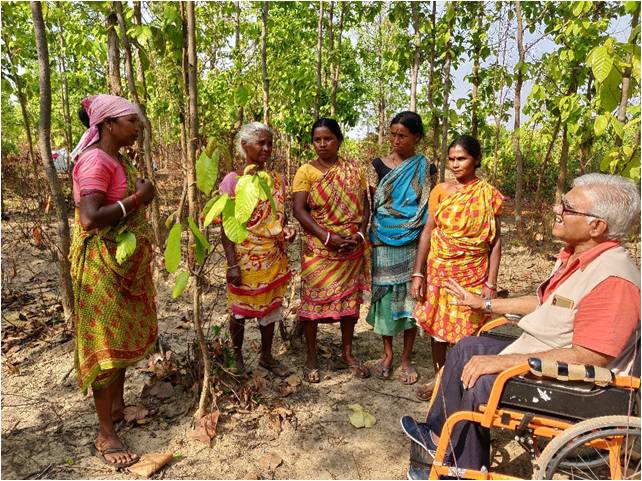
Women explaining ther traditional method of managing the forest
After the introduction of FRA and given the new responsibility to work under the guidance of Gram Sabha, it is natural that there will be some teething problem at the community level as well at the level of the government functionaries, forest department in particular.
The country, in any case, will have its public policy, Acts, and Rules. Similarly, the Community will have its own social system and regulatory mechanism as social institutions. Interestingly, both the government institutions and the social institution keep on evolving, the way ecosystem evolves. A society like a biological system is Self-Organizing System. If the two systems, Public or the Government Institution System and the Community Institutions, are compatible (Bilateral Matching Institution – Roy 1992) to evolve with the natural ecosystem, there will be “Coherent Governance” for sustainable development. However, we foresee many challenges and possible opportunities also with the advent of the FRA 2006 in the context of changing roles and responsibilities of the government and community institutions.
3.2 Preparedness for Monitoring following Scientific Criteria and Indicators of Sustainable Forest Management
The Gram Sabha as a part of the Panchayat Raj Institutions(P.R.I.)operates in a complex environment with multiple stakeholders consisting of different interest groups, competing demands with often conflicting expectations from the forest mosaic landscape. It is expected that the Gram Sabha already has registered BMC (Biodiversity Management Committee) or a JFM.C. (Joint Forest Management Committee). One may find that both the JFM.C. and BMC are functioning in harmony with the mixed ethnic Community. It will be a challenging issue to harmonize the BMC and JFM.C. with the Community Forest Resource Management S.O.Pof BMCs who enjoy statutory powers for taking actions in the context of access and benefit sharing of the biological resources of their jurisdiction. We have to learn from the experiences from such BMCs and JFM.C.s
3.3 Preparedness in understanding at Forest Mosaic Landscape Ecosystem Beyond Gram Sabha level
Forest degradation and food insecurity are perceived as the major threats to the Community at all levels.Forests, agriculture farms, and water bodies are interdependent habitats that coexist. Degradation of one will impact on the other. The tribal forest landscape is inhabited by numerous stakeholders with varied interests often with contradictory goals and expectations. Some of the groups may focus on livestock and need fodder from the forest, others need a range of NTFP (Non-Timber Forest Produce) for subsistence. The farmers need water for irrigation and would insist on overdrawing the groundwater and pollute the soil water by using excessive chemical fertilizer. Thus, in order to meet the need for all in a judicious way, there is a need for a method of nondestructive harvesting, conservation of biodiversity and water, organic farming, and awareness for “Tradeoffs Analysis” to have a balance between “Conservation and Harvest.”

The FRA 2006 provides a better opportunity for the Community to manage the forest and also have skills for sustainable livelihood. IBRAD. has attempted to create awareness and involve the Community in the trade-off analysis and develop several strategies for use of local resource for livelihood generation. The methods and approaches are illustrated in PartII of this paper. The local forest officers are involved in preparation of micro plans, and the officials of the agriculture help in vermicompost preparation.
The information and knowledge about the forest fringe habitat have to be taken into consideration for sustainable management of the CFR. The forest ecosystem does not confine under the forest boundary marked by the forest department. The Gram Sabha has to appreciate the nature of symbiotic relationship of the interdependent CFR. Herbivores and pollinators of one CFR. depend on plants growing and thriving in another CFR.Sustainable management of food chains, shelter, nutrients, and corridors isnot confined to any single CFR. within the forest boundaries, which cover essential of interdependence in nature as well. Therefore, periodical monitoring meeting above Gram Sabha at the District level with all the CFR. has to discuss for sustainable forest management plan, which is beyond the boundary of any single CFR.The Gram Sabha must be aware of the fact thatCFR. of their village is within their traditional or customary boundaries of the village and may be connected or overlapping or disjunct with other CFR. land. The sustainable forest management of their CFR. cannot be designed by ignoring the forest quality or status of the adjacent CFR. Forest management is not just tree plantation. Forest Ecosystem Management can be effective with a blend of traditional knowledge and the scientific principles of ecological interactions, even between identical forest stands.
The traditional knowledge of the Community may illustrate how the interactions among spatially dispersed stands, as keystone species, may critically influence forest ecosystems’ functioning. The forest dwellers may know that when some forest stand of one CFR. provides a critical food supply or breeding or calving habitat for any wildlife to CFR. when separated due to the boundary maintenance of the CFR.s will cause damage the entire interdependent habitats. Therefore, a sub-Division-level and District level periodical monitoring with all the interdependent CFR. holders is important for the Gram Sabha to ensure spatial and temporal management issues.
4.1 Periodical Monitoring Meeting at the Subdivision Level for Corrective Action
Periodical monitoring programs designed for forest management will provide trends and information on aspects of ecosystems with rare and endemic species and their applicability to biodiversity conservation, particularly for the species referred in the Red Data book, IUCN Some of the trees of any CFR may be important for commercial value and other CFR group may have for ecological significance.
The FRA Section 14–2 (c) states the level of officers of the departments of Revenue, Forest, and Tribal Affairs of the State Government to be appointed as members of the Subdivisional-Level Committee, the District-Level Committee, and the State-Level Monitoring Committee under Subsection (8) of Section 6. One has to be judicious in application of scientific criteria and indicators to assess the health of the forest ecosystem. The Gram Sabha should be oriented about the fact that forest management of any compartment of forest is based on the principle of ecological rotation and succession. An ecological rotation of any CFR depends upon the combination of severity, scale, pattern, and frequency of ecosystem disturbance and ecosystem resilience as a whole.So we have to engage experts to prepare forest management plans at the forest mosaiclandscape level and not at the CFR level.
4.2 Preparedneed at Government Functionaries : Re Organisaaation& Orientation
The government functionaries, forest department, in particular, have new roles to play in implementing the FRA and have to serve the objectives of the state and serve the Community following the guidelines of the Act and its rules, in whatever form prescribed. Changing position and adopting a different role by the forest functionaries requires a kind of “Business Process Re- Engineering (BPR).” The organizational structure, communication channel, and training for the new roles and responsibilities are the key factors for implementing change management for the implementation of FRA The new roles in the changing environment have to be designed in counselling with appropriate social and life skill development and adoption of digital and other relevant technology and built-in incentives for the prime movers. The Gram Sabha has to engage some ecologist or forester to overseethe forest structure and system’s health. In the forest officials’ changing role, they have to get prepared for working as an expert with sound knowledge of monitoring of the Forest Ecosystem based on the scientific criteria and indicators. The changing role will demand new life skills and social skills to work as a counsellor.
The bureaucratic organizations’ process tends to evolve slowly with time, leading to institutional resistance to change because of the job security and inherent positional power. It matters on the process of change initiated from the top and how the leaders in the organizationvisualize the better option in the new roles. For instance, if the employees feel that change is being driven because of the compulsion, it will cause frustration.

Local Forest Guard organizing meeting at Ghoghra and is participating in the Digital Training conducted by IBRAD
4.3 Application of Digital Technology at the Government Functionaries level
We find that digital technology and the e-governance activities focus mainly on change within the government department only. That change is mostly directed at changing service delivery from offline to online within the organization. Using technology to transform organizational culture and relationships with the Community has not been focused much. These innovative technological developments outside the public sector are changing citizens’ expectations of governments’ ability to deliver high-value digital services.The results of digital transformation efforts are changing the delivery mode of services also as seen the way Smartphone is used for sharing information from the field to the office. Application of digital technology can be seen as the most convenient way to share images of the satellite, which was the core issue of marking the ground realities of the forest landscape. Sharing of the pictures of the forest compartment’s status with date, latitude, and longitude has been a creation of entirely new planning models that undermine existing ways of delivering services.
Digital transformation in the implementation of the FRA and communication with Gram Sabha is seen as an opportunity to gain new professionalism in the forestry sector. FRA opens up new avenues to experience much more extensive impact on the professional services with the changing structure, roles, and culture of an organization where the foresters have to be engaging and integrating with the members at the Gram Sabha and other partners into the codesign and codelivery of improved ecosystem services.

Local Forest Gurad and Village Level Sanchalak is attending the Digital Training
4.4 Digital Ethnography Beyond the Digital Training for Tribal Development
The digital training, as innovative program designed by IBRAD has not only ignited the passion of the tribal youth for learning some new skills through online video conference, but they also picked up the skills for videography and adopt new technology for Organic Farming, plant nursery, development of herbal garden, water conservation, preparation of vermicompost, etc.

Application of Digital Ethnography to learn about the traditional livelihood of Lodha community in Nedam village, Odisha
Conducting training through digital platform
The skills of videography provided the tribal youth with the idea to document their cultural practices. The tribes of Chhattisgarh connect us with a more profound sense of understanding of their latest knowledge acquired through digital technology and take pride in their learning. The outcome of the digital training will be shared in Part II of this paper.
Digital ethnography, an emerging field for the tribal development, has been extensively used by IBRAD The experiences of day-to-day interaction between the Community and nature is documented, sent to us through the digitally connected WhatsApp, and saved in the computer for documentation of the experiences.
The problems, issues of conservation of forests by the communities are discussed through the smartphones for discussion through video conference providing options for training needs, resources, and participating Community expectations. Immediately after the training, a follow-up plan of action is prepared. We must add here that digital training in its classical form is different from digital ethnography.Here, in Digital Ethnography, the emphasis is more on understanding the people, the natural ecosystem, cultural practices, and existing social structure and the institutions, which impact the day-to-day cultural practices related to Conservation-Based Sustainable Livelihoods.As an ethnographer, one has to appreciate the social phenomena of various kinds that are manifested, a worthy area for interpretation and development of a strategic plan to develop appropriate social institutions. The digital ethnography continues the tradition of story-telling to understand the Community’s social processes and world view.
5.1Socio Ecological Approaches for Integrated Forest Mosaic Landscape Management

The act intends to provide tenurial security, which could be a strong incentive for sustainable use of land (Kothari et al 2011), whereas in reality, the smallholder tribals, PVTG, or other traditional forest dwellers/patta holders lack access to required knowledge, skills, and technology to utilize the lands, which are mostly rainfed, undulating, and suffer from poor soil health. This is why both the productivity and yield arelow.
In a study conducted by IBRAD in the villages of Ghoghra under Kabirdham district, Chhattisgarh, and Nedam under Mayurbhanj district, Odisha, reveals that out 15 and 17 patta holders in these two villages, respectively, only 21% could utilize the entire land for cultivation, whereas 25% (all of them belonging to Nedam village) could not use the land for cultivation at all. Out of the eight persons who could not cultivate the land, four have habitation on the land, one has planted fruit trees with support from IBRAD, and for the rest three, the land is covered by sal (Shorearobusta) trees. The percentage utilization of land for the rest of the respondents varies between 30% and 60% where rainfed paddy or KodoandKutki are cultivated during the monsoon season.

A Patta holder is explaining the difficulty of cultivating the land received year-round.
It requires a socio-ecological approach for managing the lands received under FRA following the Integrated Forest Mosaic Landscape Management principles. Community institutions are built and strengthened for understanding the interdependence of the different ecosystems such asforest, water, agriculture, livestock, and the human within the forest mosaic landscape and appreciate that the change in one would induce a change in the functioning of other ecosystems too. Hence, it necessitates developing a comprehensive plan covering all the constituent ecosystems of the forest mosaic landscape. Since people of different interests habit the forest mosaic landscape, Common Interest Groups with like-minded people are formed to take care of the interdependent components, for example, cultivation of horticulture and agriculture crops in a sustainable manner, fishery, vermicompost preparation, NTFP processing, fodder cultivation etc. Participatory micro plan of the village/gram Sabha landscape is prepared by using PRA(Participatory Rural Appraisal Tools) and involving the villagers, panchayat members, and line departments such as forest.

Participatory planning exercise at Dhengura village
5.2 Actions of the Common Interest Groups (CIG) for Conservation-Based Livelihood Development of the Smallholder Farmers of the Forest Mosaic Landscape

Organic Nutrition Kitchen Gardens
Several studies revealed that the organic kitchen gardens in the backyard of the tribal households can be raised for food and nutrition security as well as earning extra income by the smallholder farmers (Poshadri et al 2019, Parida et al 2018, Suri 2020). The approach of IBRAD. to build capacity of the smallholder farmers, particularly the women to establish organic nutrition gardens in their homestead land to produce organic food covering more than 200 PVTG tribal communities covering the villages of Ghoghra and Bhurbhuspani in Kabirdham district, Chhattisgarh, Nedam, Nuagaon, and Dengam villages under Mayurbhanj district, and Kutruguda and Sikerguda villages under Kalahandi district, Odisha, and Tatiba village under West Singhbhum district, Jharkhand, since August 2020, is found to be effective. The organic farming method helps maintain soil health and soil moisture content (Reeve et al 2016, Seufert et al 2017). This household-level low-input, zero-emission production model is best suited for the smallholder farmers that also improves the resilience of the people against climate-induced shocks and stresses (Sartaj et al 2013, Azadi et al 2011).It is also found how convergence with the local agriculture department for dovetailing the existing schemes for providing inputs such as earthworms for the production of vermicompost in Ghoghra village in Chhattisgarh has been effective.


Mulching after seed sowing by the Baiga community at Ghoghra village in Chhattisgarh
Participatory Water Conservation for Irrigation and Fishery
Section 3(1)(d) of the Act mentions about “other community rights of uses or entitlements such as fish and other products of water bodies, grazing (both settled or transhumant) and traditional seasonal resource access of nomadic or pastoralist communities.” Section 5 (b) of Chapter III of the Act also mentions that “the holders of any forest right, Gram Sabha and village level institutions in areas where there are holders of any forest right under this Act are empowered to (b) ensure that adjoining catchments area, water sources and other ecologically sensitive areas are adequately protected.” The study conducted by IBRAD. among 15 respondents of Ghogra and 17 respondents of Nedam village who have received land under FRA reveals that for 73% of the people in Ghogra, the source of water for irrigation is at a distance of 1km or more, and in case of Nedam, it is at a distance of 500 m or more for 18% of the respondents, whereas 12% of them do not have access to any source of water for irrigation. Increased irrigation water control is crucial for improving the livelihood of the tribal Community and kick-start the tribal economy (Phansalkar and Verma 2004). Based on the microplan, the Baiga community of Ghoghra–Bhirbhuspani village is organized to form a group and conserve the surface water by constructing Loose Boulder Check Dam across KauaNala at the fringe of the village Bhurbhuspani. The stored water is being used for irrigation that results in introduction of new crops in the Rabi season by 12 families in Bhurbhuspani village.

Water conservataion by the Baiga community at Ghoghra village
Community aquaculture and small-scale pond fish farming can provide a viable option for developing livelihood of the smallholder tribal community (Barik 2012, Patil 2013). In Ghoghra village, two such ponds, School Talab and Nunmatti, are put under fish cultivation by the two CIGs formed with 10 members in each group by the Baiga PVTGs, and in Nedam village, 10 CIGs are formed with five members in each group who have started fish cultivation in 10 ponds.
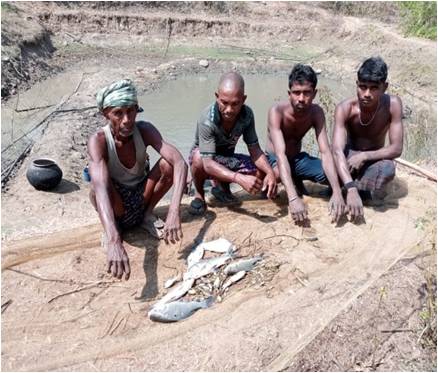
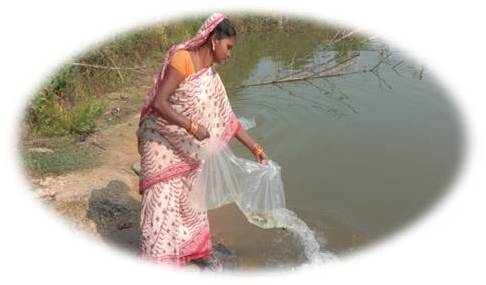
Pasture Development for Grazing and Ensuring Livestock Health
The pasture lands are covered with annual and perennial plants that are mostly self-seedling, and it also provides host of ecosystem services (Marzban and Valizade 2020). Sustainable agriculture practices too cannot be achieved without good health of the livestock (Kijlstra and Eijck 2006). It is encouraging to determine how the Lodha community in Nedam village in Odisha has formed two CIGs with five members in each group, identified 18-decimal fallow land that is under occupation of DukhiramBhukta, which is developed as pasture land.
Conservation of Rare and Endangered Medicinal Plants Through Establishment of Herbal Garden
The Section 3(1)(i) of the Act mentions about “rights to protect, regenerate or conserve or manage any community forest resource which they have been traditionally protecting and conserving for sustainable use.”The age-old traditional knowledge and practices of the community help in harnessing the natural resources from their habitats in a sustainable manner (Mukhopadhyay and Roy 2015). Section 2 (o) of the Biological Diversity Act 2002 interprets the sustainable use as “the use of components of biological diversity in such manner and at such rate that does not lead to the long-term decline of the biological diversity thereby maintaining its potential to meet the needs and aspirations of present and future generations.” Section 41 (1) of the same Act mentions about preservation of habitats, conservation of land races, folk varieties, and cultivars by the Biodiversity Management Committee. Thus, both the Acts emphasize upon sustainable use of the biodiversity. Several studies argued for adopting ex situ and in situ conservation strategies and good agriculture practices for resource management toensure both conservation and sustainable use of the medicinal plants (Chen et al 2016). Medicinal plants conservation-based livelihood can be a viable option for the tribal Community (Kala 2009) and also provide health support and maintain the cultural identity (Pei et al 2010). IBRAD. has engaged the local vaids and the Baiga, Lodha, and Birhor PVTGs of Ghogra, Nedam, and Tatibal villages to identify the medicinal plants available in the forest areas. The Baiga community has identified 12 plants and set up an herbal garden on the land of DharamsayBaigainGhogra village. In Nedam village, 36 plants are planted in the herbal garden established by the Lodha community in half-acre land used by Ramesh Bhakta.

Indegenous seed conservation
Several studies revealed how indigenous communities are, through conservation and promotion of traditional food systems, enhancing their resilience (Duthie-Kannikkatt eta al., 2019). People are organized to conserve the indigenous seeds, land races, and cultivars including highly nutritious millets, tubers, cereals, and other agriculture crops that are becoming rare or at the verge of extinction. These crops are resistant to extreme climatic conditions, disease, and pest, require less water and external inputs, and provide high nutrient values (Ceccarelli2011, Berg 2009, Ghosh–Jerath et al 2015, Ficiciyan et al 2018). Now, Baiga women of Bhurbhuspaniare organized by IBRAD. to conserve the seed of traditional cultivars and for multiplication of the seeds.
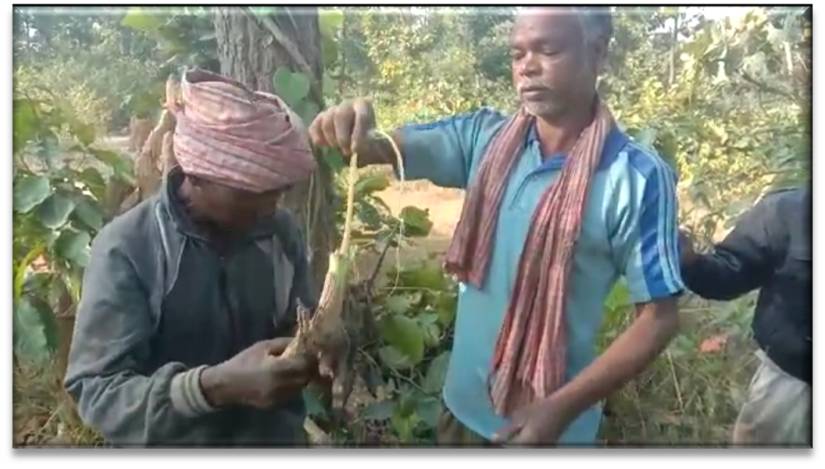
Local Traditional healers are identifying the Rare and Endangered Medicinal Plants in the forest areas
Establishment of Community Nursery and Plantation of Fruit Plants
In Ghogra village, one CIG is formed with five members, Lohar Singh, Tomar Singh, Rabi Singh, Suman Singh, and Shyam Singh, who have established two nurseries and have prepared 150 pots for raising saplings. Similarly, in Nedam village too, one CIG is formed, who have prepared two nurseries. It is quite encouraging to note how the Birhor tribes of Demotand village in Jharkhand have produced 500 chili saplings in the nursery established by them after being trained by IBRAD.

Nursery prepared by the Birhor community at Demotand village, Jharkhand
Fruit trees plantation is taking place in Nedam and Kuturguda villages in Odisha involving Lodha and KutiaKond PVTGs respectively to meet the nutrition requirements of the tribal Community who in general are suffering from malnutrition (Verma et al 2020).
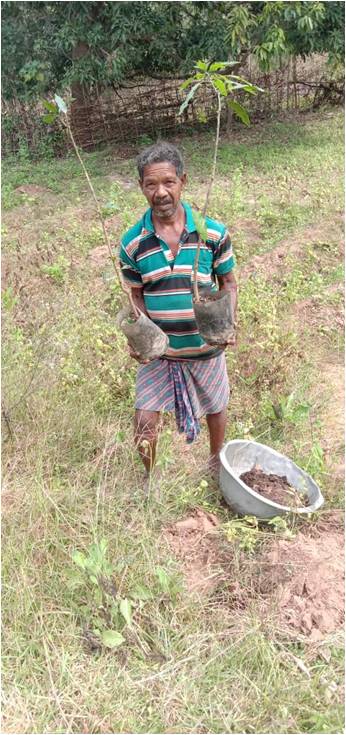
Fruit tree plantation in the land received under FRA 2006 in Nedam village, Odisha
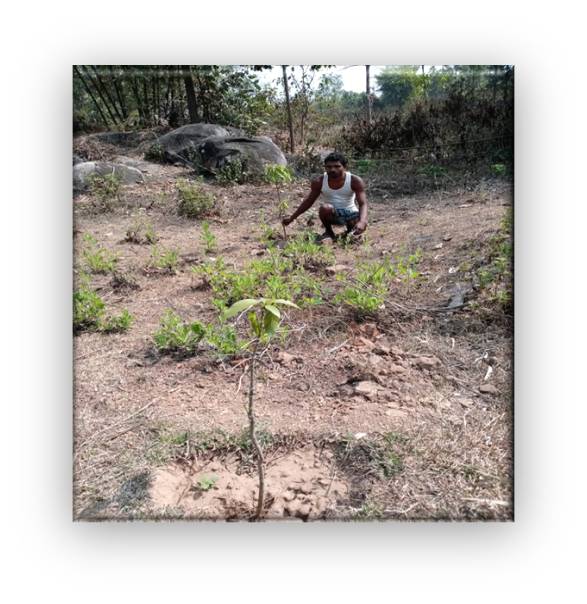
The fruit tree garden in the land received under FRA 2006 in Nedam village, Odisha
Nondestructive Harvesting, Processing, and Marketing of the NTFPs
The Scheduled Tribes and Other Traditional Forest Dwellers (Recognition of Forest Rights) Rules, 2008, as amended by the Ministry of Tribal Affairs in 2012, under Rule 4 (1) (e), provide that Gram Sabha shall constitute “Committees for the protection of wildlife, forest and biodiversity from amongst its members, in order to carry out the provisions of section 5 of the Act.” Forest provides a wide range of livelihoods for tribal communities by providing food and NTFP-based self-employment (Sarangi 2019, Islam and Quli 2016). It is also revealed through the study conducted among the Baiga communities in Ghoghra village that a sizeable income of the patta holders still comes from the forest-based NTFPs. Pameli Bai Baiga of Ghoghra village, who has received three acres of land under FRA, earns about Rs 9000 annually by selling produces from Mahua and Kendu trees. Same is true for Ramu Ram, who has also received three acres of land under FRA, and only 60% of it is cultivable. Capacity building of the Community for nondestructive harvesting, value addition, and processing of the NTFPs and marketing through branding and promotion would help both in conservation and in livelihood security of the tribal Community.
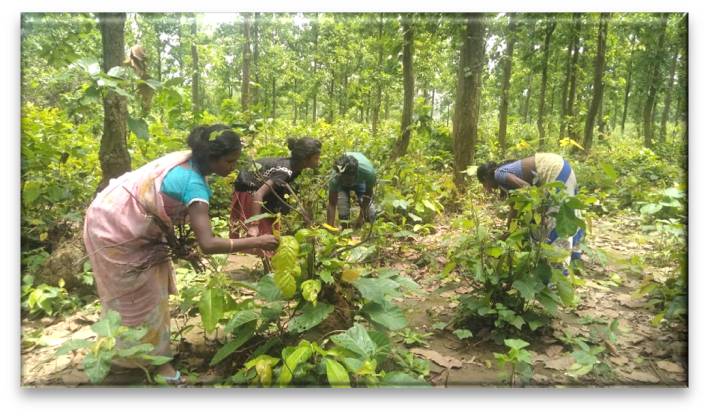
Women are collecting NTFPs in Nedam village, Odisha
6.0 Conclusion
Sustainable tribal development can only be achieved by adopting participatory and integrated landscape management within the tribal habitat with proper understanding and strengthening the inter-linkages between different ecosystems’ components. Forest Right Act 2006 enables the local and forest dependent Community to use their traditional knowledge and customary systems for conserving and sustainably managing their natural resources, including their neighbourhood forests in a participatory manner. Gram Sabha, the grass-root democratic institution is vested with the authority to initiate as well as to monitor implementation of the act at village level initiate the process as per the act. However, the implementation of more than a decade old act is far from what is desired. Number of local level socio, cultural, political, organizational, administrative, geographical, awareness issues combined with lack of inter departmental coordination impediment the effective implementation of the act. Various studies across the country indicate that this act’s governance system, particularly the functions, responsibility, and accountability of members at local and divisional levels, is quite vague without well-defined and measurable performance indicators. Based on accumulated experience in FRA implementation, this paper reveals that hardly one-fourth of patta holders under FRA could fully utilize the allotted land due to lack of technical knowledge and resources to cultivate the rainfed, undulated and mostly unfertile land. Hence, it suggests urgent reforms in supporting and governance systems of the act in terms of key-strategies for a participatory, transparent and accountable governing regime for implementing and monitoringFRA 2006. The strategies envisage positive actions on the part of the govt. departments, particularly Revenue, Forest and Tribal affairs that are mainly responsible for implementing the act in partnership with the Gram Sabha. Specifically, Gram Sabha and other stakeholders’ competence in scientific monitoring of FRA implementation with SOPs has to be enhanced. Further, their awareness on ‘Tradeoffs analysis’ to balance’Conservation and Harvest’ to be increased. Compatibility between community-based institutions and govt. Departments is crucial. Blending the community’s traditional knowledge with scientific principles is needed to achieve sustainable ecosystem management. Increased use of digital technologies will ensure better implantation and monitoring of FRA. The case studies related to community-level participatory management of various natural resources quoted from different regions adequately authenticate the need for these reforms in the existing governance system.


